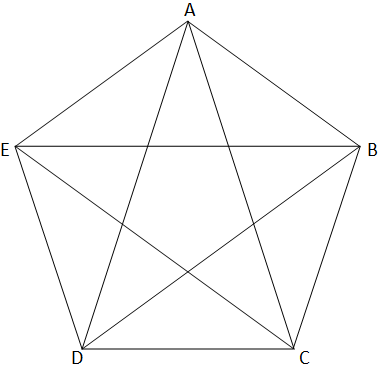
How many diagonals does a regular pentagon have?
\[
A.{\text{ 3}} \\
B.{\text{ 4}} \\
C.{\text{ 5}} \\
D.{\text{ 6}} \\
\]
Answer
604.5k+ views
Hint: Use the relation between the number of sides of any figure and the number of diagonals of the figure to find out directly the number of diagonals. Using diagrams for finding can also be done.
Complete step-by-step answer:
Given shape is a regular pentagon. We know that a regular pentagon has 5 sides.

Also we know the relation between the number of sides and number of diagonals of the figure.
If a figure has “n” number of sides in it then the number of diagonals of the figure is given by
$ \Rightarrow {\text{ Number of diagonals}} = \dfrac{{n\left( {n - 3} \right)}}{2}$
For regular pentagon number of sides = 5.
$ \Rightarrow n = 5$
So the number of diagonals of regular pentagon is given as:
$
\Rightarrow {\text{ Number of diagonals}} = \dfrac{{n\left( {n - 3} \right)}}{2} \\
\Rightarrow {\text{ Number of diagonals}} = \dfrac{{5\left( {5 - 3} \right)}}{2} \\
= \dfrac{{5 \times 2}}{2} = 5 \\
$
Hence, the number of diagonals of a regular pentagon is 5, which is also visible from the above figure.
So, option C is the correct option.
Note: Such type of question can also be done by simply drawing the figure and visualizing the result from the figure. But this method cannot be used when the number of sides in the figure will be very large. So remembering formulas is very important for solving such problems. Also students must remember that this formula has been derived by the method of permutation and combination.
Complete step-by-step answer:
Given shape is a regular pentagon. We know that a regular pentagon has 5 sides.

Also we know the relation between the number of sides and number of diagonals of the figure.
If a figure has “n” number of sides in it then the number of diagonals of the figure is given by
$ \Rightarrow {\text{ Number of diagonals}} = \dfrac{{n\left( {n - 3} \right)}}{2}$
For regular pentagon number of sides = 5.
$ \Rightarrow n = 5$
So the number of diagonals of regular pentagon is given as:
$
\Rightarrow {\text{ Number of diagonals}} = \dfrac{{n\left( {n - 3} \right)}}{2} \\
\Rightarrow {\text{ Number of diagonals}} = \dfrac{{5\left( {5 - 3} \right)}}{2} \\
= \dfrac{{5 \times 2}}{2} = 5 \\
$
Hence, the number of diagonals of a regular pentagon is 5, which is also visible from the above figure.
So, option C is the correct option.
Note: Such type of question can also be done by simply drawing the figure and visualizing the result from the figure. But this method cannot be used when the number of sides in the figure will be very large. So remembering formulas is very important for solving such problems. Also students must remember that this formula has been derived by the method of permutation and combination.
Recently Updated Pages
Master Class 10 General Knowledge: Engaging Questions & Answers for Success

Master Class 10 Computer Science: Engaging Questions & Answers for Success

Master Class 10 English: Engaging Questions & Answers for Success

Master Class 10 Social Science: Engaging Questions & Answers for Success

Master Class 10 Maths: Engaging Questions & Answers for Success

Master Class 10 Science: Engaging Questions & Answers for Success

Trending doubts
The shortest day of the year in India

Why is there a time difference of about 5 hours between class 10 social science CBSE

Write a letter to the principal requesting him to grant class 10 english CBSE

What is the median of the first 10 natural numbers class 10 maths CBSE

The Equation xxx + 2 is Satisfied when x is Equal to Class 10 Maths

State and prove converse of BPT Basic Proportionality class 10 maths CBSE




